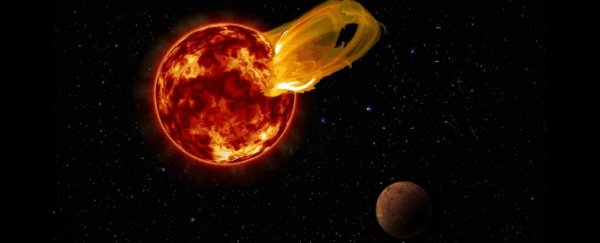Our closest stellar neighbour, Proxima Centauri, knows how to belch 'em out. According to new research, in March of last year it erupted into an absolute beast of a stellar flare, 10 times brighter than the largest flares produced by our own Sun, even though it has only about one-eighth of the mass.
This puts a damper on the notion that the red dwarf is being orbited by a plethora of planets, as was determined by a team of researchers last year.
Based on a reanalysis of the same data, it now looks like there's no dust ring after all, as previously thought.
In November last year, researchers from the Institute of Astrophysics of Andalusia (IAA) in Spain announced that they'd detected a glow coming from Proxima Centauri.
They attributed this glow to a ring of dust, like the asteroid belt orbiting the Sun on the far side of Mars, or the Kuiper belt out past Pluto.
This, they believed, could indicate the presence of an entire planetary system orbiting outside the exoplanet Proxima b, which had been confirmed in 2016.
This is because dust and asteroid belts are leftover from the accretion disc of dust that swirls around a forming star, and which can result in the formation of planets.
According to a team of researchers led by Carnegie's Meredith MacGregor, this interpretation of the data now appears flawed.
The extra light detected by the IAA researchers, their new analysis suggests, wasn't reflected light from a dust ring, but the result of a massive solar flare.
So how did the two teams arrive at such different conclusions based on the same data?
Both teams looked at 10 hours of data captured by the Atacama Large Millimeter/submillimeter Array, a radio telescope comprising 66 antennas, taken from 21 January through 25 April 2017.
The IAA team based its finding on the average amount of light over those three months, including the light of the star and the flare together to result in the dust cloud interpretation.
MacGregor's team, on the other hand, did not average out the data, but analysed it as a function of observing time - resulting in a spike in the star's emission.
On 24 March, 2017, they found, the star erupted into an absolutely massive solar flare - 1,000 times brighter than the star's normal emissions, over a period of 10 seconds.
Overall, the event lasted less than two minutes.
We know Proxima Centauri has a great deal of flare activity, so this wouldn't be entirely out of character for the star. But it also lowers the chances for finding life on Proxima b, a rocky planet about 1.3 times the mass of Earth.
Because the star is so cool and dim, the planet has to orbit very close to the star in order to be within the habitable zone. This means that it's much more likely to get lashed by stellar flares, which could strip away its atmosphere, if it even had one to start with.
"It's likely that Proxima b was blasted by high energy radiation during this flare," MacGregor said.
"Over the billions of years since Proxima b formed, flares like this one could have evaporated any atmosphere or ocean and sterilised the surface, suggesting that habitability may involve more than just being the right distance from the host star to have liquid water."
That doesn't mean all hope is lost, however. There may still be planets orbiting Proxima Centauri that we can't see.
In fact, we can't even see Proxima b either. It was found back in 2015 using Doppler spectroscopy, which confirms planets based on the very small changes in light when a star moves towards or away from us, tugged by the gravitational pull of an orbiting body.
Because we can't see the planet directly, any other planets on the same orbital plane would likewise be invisible. But, so far, there has been no indication that there are any more planets, especially now that the dust cloud finding has been called into significant doubt.
"There is now no reason to think that there is a substantial amount of dust around Proxima Cen[tauri]," said co-author Alycia Weinberger of Carnegie.
"Nor is there any information yet that indicates the star has a rich planetary system like ours."
We'll just have to keep looking.
The team's paper has been published in The Astrophysical Journal Letters, and can be read in full on arXiv.
